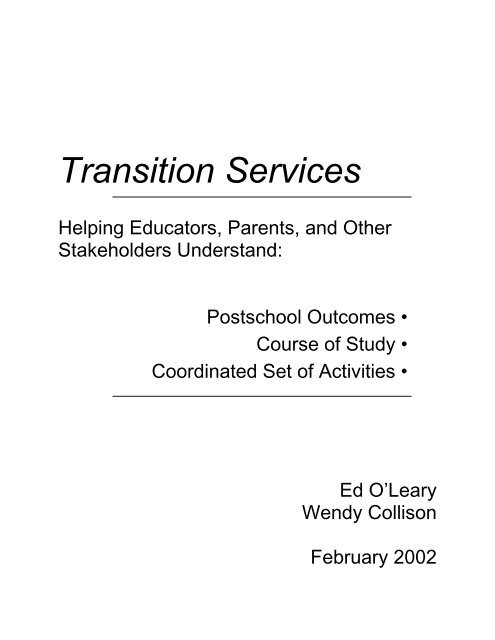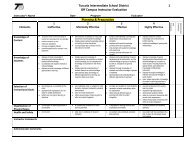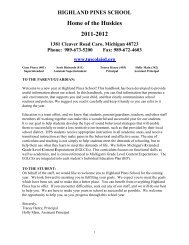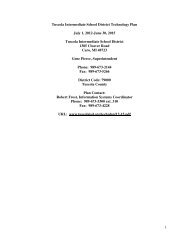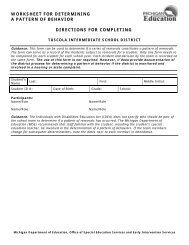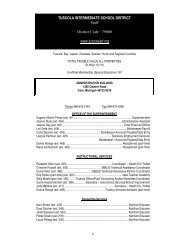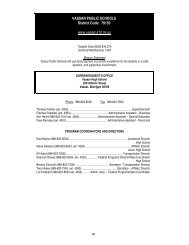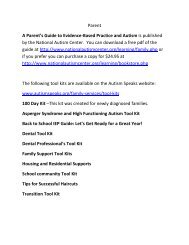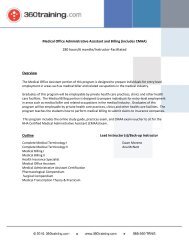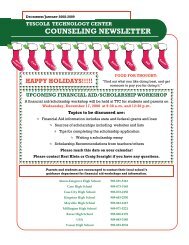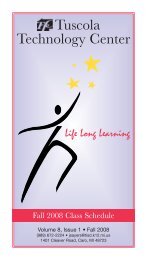Ed O'Leary's Transition Services Guide
Ed O'Leary's Transition Services Guide
Ed O'Leary's Transition Services Guide
- No tags were found...
Create successful ePaper yourself
Turn your PDF publications into a flip-book with our unique Google optimized e-Paper software.
<strong>Transition</strong> <strong>Services</strong>Helping <strong>Ed</strong>ucators, Parents, and OtherStakeholders Understand:Postschool Outcomes •Course of Study •Coordinated Set of Activities •<strong>Ed</strong> O’LearyWendy CollisonFebruary 2002
Adapted from:Haugh, B., & Freeman, B. (2001). Sample Strategies/Activities for Statements of Needed <strong>Transition</strong> <strong>Services</strong>. Trenton,NJ. The New Jersey Department of <strong>Ed</strong>ucation Office of Special <strong>Ed</strong>ucation Programs.Junge, C. (2000). Needed <strong>Transition</strong> <strong>Services</strong>: Coordinated Activities and Strategies to Meet Outcomes. Casper, WY.Natrona School District #1.Lehman, Martha (2001). <strong>Transition</strong> IEP Agenda. Helena, MT. Montana Office of Public Instruction.McCorkle, Dick (2001). Joe Schell’s IEP. Harrisburg, PA. Pennsylvania Training and Technical Assistance Network(PATTAN).Storms, J., O'Leary, E., & Williams, J. (2000). The Individuals with Disabilities <strong>Ed</strong>ucation Act of 1997 transitionrequirements: A guide for states, districts, schools, universities and families. Minneapolis, MN: University ofMinnesota, Institute on Community Integration, National <strong>Transition</strong> Network.<strong>Ed</strong> O’Leary is a Program Specialist for Mountain Plains Regional Resource Center. Wendy Collison is the <strong>Transition</strong>Specialist for the Arizona Department of <strong>Ed</strong>ucation.Copyright 2002, <strong>Ed</strong> O’Leary and Wendy Collison
Table of ContentsIntroduction . . . . . . . . . . . . . . . . . . . . . . . . . . . . . . . . . . . . . . . . . . . . 3Postschool Outcomes . . . . . . . . . . . . . . . . . . . . . . . . . . . . . . . . . . .Employment . . . . . . . . . . . . . . . . . . . . . . . . . . . . . . . . . . . . . . .Community Participation . . . . . . . . . . . . . . . . . . . . . . . . . . . . . .Residential . . . . . . . . . . . . . . . . . . . . . . . . . . . . . . . . . . . . . . . .Leisure and Recreation . . . . . . . . . . . . . . . . . . . . . . . . . . . . . . .Postsecondary <strong>Ed</strong>ucation . . . . . . . . . . . . . . . . . . . . . . . . . . . . .Putting it Together—Examples of Specified Postschool Outcomes .5667778Statement of <strong>Transition</strong> Service Needs—Course of Study . . . . . 11Statement of Needed <strong>Transition</strong> <strong>Services</strong>— Coordinated Setof Activities . . . . . . . . . . . . . . . . . . . . . . . . . . . . .Sample <strong>Transition</strong> Activities . . . . . . . . . . . . . . . . . . . . . . . . . . .Instruction . . . . . . . . . . . . . . . . . . . . . . . . . . . . . . . . . . . . . . . . .Related <strong>Services</strong> . . . . . . . . . . . . . . . . . . . . . . . . . . . . . . . . . . . .Community Experiences . . . . . . . . . . . . . . . . . . . . . . . . . . . . . .Employment . . . . . . . . . . . . . . . . . . . . . . . . . . . . . . . . . . . . . . .Postschool Adult Living . . . . . . . . . . . . . . . . . . . . . . . . . . . . . .Daily Living Skills . . . . . . . . . . . . . . . . . . . . . . . . . . . . . . . . . . .Functional Vocational Evaluation . . . . . . . . . . . . . . . . . . . . . . .152325272931333537IEP Meeting Agenda . . . . . . . . . . . . . . . . . . . . . . . . . . . . . . . . . . . . . 391
Postschool Outcomes“<strong>Transition</strong> <strong>Services</strong>” means a coordinated set of activities for a student, designed within an outcomeorientedprocess that promotes movement from school to postschool activities, includingpostsecondary education, vocational training, integrated employment (including supportedemployment), continuing and adult education, adult services, independent living, or communityparticipation. [§300.29]IDEA has always promoted the concept that transition services was “an outcome-oriented process”and that this process should help students move from the school setting to whatever they may want todo postschool. While it has been stated that this process and thinking should be a part of everystudent’s IEP from 14 years of age on, many special educators have not put into practice an outcomeorientedapproach to planning, discussion, and decision-making in the IEP. This means that if the IEPof every student 14 years of age and older is to be outcome-oriented, then the IEP process and teammust begin the IEP discussion and decision-making with the student’s desired postschool outcomes inmind. One could get into lengthy discussion about student’s not knowing what they want to do ormany students not being realistic. This paper is not the forum for that discussion and debate. Sufficeto say that regardless of whether a student knows precisely what they want to do or whether theyinitially state something that appears unrealistic, the IEP discussion must start with and focus on thestudent’s outcomes. Given that, the IEP team should list specific information for each postschooloutcome in the areas suggested below:• Employment.• Community participation.• Residential.• Social and recreational.• Mobility.• Postsecondary education.These outcome areas were chosen because they represent major adult life activities around whichplanning should take place. This does not mean that other postschool outcome areas could not bechosen. Other areas could be chosen based upon the student’s anticipated needs, interests, andpreferences as well as the IEP team’s input. For the sake of discussion, these broad areas were chosento provide examples of possible postschool outcomes and how they might be recorded as a part of theIEP.Remember, this information should be based upon the student’s preferences, interests, and needs. Byaddressing the desired postschool outcomes in the areas listed above, one is developing a BIG pictureof a student’s life. The discussion, planning, and decision-making in the IEP that will lead towardthose outcomes will provide educators with a direction for decision-making in educationalprogramming, school, and community experiences; special education and other services; and neededsupports. Ultimately, this type of long-range thinking and planning should5
esult in an IEP that is outcome-oriented and a plan that will prepare students for postschooladult life.Based upon the major postschool outcome areas identified above, below are examples ofpossible postschool outcomes that could be identified in a student’s IEP. Remember, theidentification of postschool outcomes are broad statements of what the student desires in eachmajor adult life area; they are not goals or objectives.EMPLOYMENTThe student (or family) wants—• To be independently employed and knows the field he/she wants to study or pursue(be specific).• To be independently employed but does not know in what field.• A job, and the IEP team anticipates the need for time-limited supports (e.g., a jobcoach).• A job, and the IEP team anticipates supported employment (e.g., long-term support—job coach or natural supports).• Organizational employment through an adult service provider (e.g., enclave, mobilecrew, or contract work).• Sheltered employment through an adult service provider.• Day habilitation services through an adult service provider.• Other…COMMUNITY PARTICIPATIONThe student (or family) wants—• To be independently mobile in the community and access services of choice (specifyservices).• To be independent in the community with the support for transportation to accessservices of choice (specify services).• Community access with the support of family and friends for accessing services ofchoice.• Community access with a provider.• Other…6
RESIDENTIALThe student wants to—• Live independently without support.• Live in a supervised living arrangement.• Live with a friend.• Live on a military base.• Live in a dorm room while attending postsecondary education.• Live with a support staff roommate.• Live in a group home.• Live in a family home with support.• Live in a specialized care facility.• Other…LEISURE AND RECREATIONThe student has—• Identified specific recreation/leisure activities of choice and can participate independently(specify activities).• Identified specific community facilities to join for recreation/leisure services (specify facilitiesor organizations).• Identified activities of choice to do with family members or friends.• Identified activities of choice to do with a provider.• Participated/participates with group activities supported by a provider.• Other…POSTSECONDARY EDUCATIONThe student wants to attend—• A four-year college or university to gain a degree in a specific field.• A four-year college or university but is unsure of what field he/she will pursue.• A community college prior to continuing in a four-year program.• A community college.• A community college for nonacademic courses (specify).• A vocational training program in a specified field.7
• A nonacademic courses at the local library, through a local nonprofit organization, orthrough other avenues (specify).• Other…PUTTING IT TOGETHER–EXAMPLES OFSPECIFIED POSTSCHOOL OUTCOMESEmployment:• Wants to be a carpenter.• Desires employment in the field of security.• Wants to go to college to be a teacher.• Work in an enclave in the janitorial field.• Obtain a job in data entry with the assistance of a job coach.• Undecided about a field of interest but does want a full-time job working outdoors andaround people.Community:• Wants to obtain a driver’s license to be independently mobile within the community.• Wants to become a member of the local church youth group.• Wants to join a softball league.• Be able to independently visit the grocery store (or other business) without a provider.• Learn where the main community services are located (i.e., post office, grocery store,bank, and mall) to access with a friend.Residential:• Wants to live in an apartment with a friend.• Live in a dorm while attending college.• Remain at home with family with a habilitation provider coming in to help learn dailyliving skills.• Live-in group home.• Would like to become a homeowner.8
Recreation/Leisure:• Enjoys fishing, biking, and shooting pool.• Likes to be outdoors with friends having picnics in the park.• Enjoys music concerts and singing in the local youth choir.• Participates in Special Olympics but wants to find other clubs with organized sports.Postsecondary:• Wants to attend a university to obtain a degree in business.• Wants to attend University of Phoenix Online to obtain a college degree while also being ableto maintain a job.• Attend the local community college for a dance class.• Take a gardening class at the local Home Depot.• Attend community college to get an AA degree before deciding on whether to pursue a fouryearcollege.• Attend Maricopa Skills Center to gain certification in culinary arts.9
Statement of <strong>Transition</strong>Service NeedsCourse of StudyNow that the postschool outcomes have been articulated and the IEP team has an understanding ofthe student’s vision for the future, courses of study and educational experiences need to bedetermined and addressed over multiple years. When the IDEA of 1997 went into effect, it called forIEP teams to develop a statement of transition service needs by the age of 14, or younger ifappropriate.There were several reasons why this requirement was put into place for all students 14 years of ageand older. One of the primary reasons was to reduce the dropout rate of students with disabilities (38percent for students with disabilities vs. 28 percent for the general population). The idea was, by age14, to actively involve the student, IEP team, and family in designing and planning an educationalprogram (all courses of study as well as all educational experiences) that would show a directrelationship between what the student will be taking and their desired postschool outcomes. It wasfelt that if the student was actively involved in this type of discussion, planning, and decision-makingand if the educational program plan responded to their desired postschool outcomes, then studentsmight for the first time see why school is relevant and meaningful, and thus they just might have avested interest in remaining.The expectation is that all courses and educational experiences should directly relate to the student’spostschool vision or desired outcomes. While the level of specificity in the identification of coursesand educational experiences is not dictated in the law, common sense would suggest that the morespecific one can be in identifying the courses and show how they relate to the student’s desiredoutcomes, the greater the likelihood students will see the relevance and importance of the coursesthey will be taking, which should increase the likelihood that they would remain in school.While the course of study and listing of specific educational courses and experiences would mostlikely follow the course offerings of the general population, the course of study for students withmoderate or severe disabilities would be different. Instead of the listing or specific course titles, forstudents with moderate to severe disabilities one should list course content areas (e.g., mobility, selfdetermination,independent living, money management, personal relationships, etc.).11
For a student with a mild disability, an example of the desired postschool outcomes and theresulting course of study might look like this:POSTSCHOOL OUTCOME/VISIONEmployment:Community Participation:Recreation & Leisure:Postsecondary Training &Learning Opportunities:Independent Living:I would like to become a social worker, like the kind who helps kids who havebeen abused or neglected.I enjoy cooking for my parents and would like to volunteer making foodbaskets and serving meals to the homeless.I want to learn more about yoga and Tai Chi. I enjoy spending time outdoorswith my friends playing Frisbee and soccer.I want to start out at a community college taking classes that will prepare mefor a four-year university and then apply to a four-year college to get a degreein social work.I plan to live with my parents while going to a community college for twoyears and then live in a dorm at the university. Eventually, I want to getmarried and have a house of my own.COURSE OF STUDYYear 1 – Age 14/15 Year 2 – Age 15/16 Year 3 – Age 16/17 Year 4 – Age 17/18Math I Math II Math III First Aid/CPREnglish I English II English III English IVWorld History P.E. American History Govt./Free EnterpriseBiology Earth Science Early Childhood Devel. PsychologyKeyboarding/Health Culinary Arts I/II Culinary Arts III/IV Comm. Based Empl.Career Exploration Human <strong>Services</strong> TA in kinder classroom Comm. Based Empl.For a student with a more moderate disability, an example of the desired postschool outcomesand the resulting course of study might look like this:POSTSCHOOL OUTCOME/VISIONEmployment:CommunityParticipation:Recreation & Leisure:PostsecondaryTraining & LearningOpportunities:Independent Living:I would like to work around people and animals.I like sports and participating in the Special Olympic Program. I attend asingle’s group at church and sing in choir.I will continue to be active in Special Olympic and church activities. I amlooking into participating in a bowling league. I like to fish and camp and willcontinue these outdoor activities. I also watch TV.Looking at working full-time after graduation so any training will beon the job.I will be capable of living with a friend or roommate but will need assistancewith budgeting, buying food, and paperwork related to paying monthly bills.12
COURSE OF STUDYYear 1 – Age 14/15 Year 2 – Age 15/16 Year 3 – Age 16/17 Year 4 – Age 17/18LS Math LS Math LS Math-moneymanagementLS Math-purchasingand budgetingLS Language Arts LS Language Arts LS Language Arts LS Language ArtsSocial Living Social Living Portfolio Development Portfolio DevelopmentEmployment Skills Community Based Work Experience Work ExperienceInstructionCommunity Training Portfolio Development Food Preparation P.E.P.E. P.E. Daily Living Skills Daily Living Skills.Art for Enjoyment Community BasedAssessmentP.E.Independent LivingSkillFood Preparation Social Living Social Living* LS = Life Skill13
Statement of Needed<strong>Transition</strong> <strong>Services</strong>Coordinated Set of ActivitiesIEP teams need to include in the IEPs of all students with disabilities who are age 16 and above (oryounger if appropriate) a statement of needed transition services that includes strategies/activitiesthat will assist the student to prepare for postsecondary activities such as postsecondary education,vocational training, integrated employment (including supported employment), continuing and adulteducation, adult services, independent living, community participation, or whatever it is the studentdesires to do. While a listing of possible postschool activities is identified in the law, one shouldkeep in mind that this list is not exhaustive; this list provides only some examples of thepostsecondary activities that students may choose or need.The statement of needed transition services shall be based on the individual student's needs, takinginto account the student's preferences and interests, and shall include:1. Instruction.2. Related services.3. Community experiences.4. The development of employment.5. Other postschool adult living objectives.And, if appropriate:6. Acquisition of daily living skills.7. Functional vocational evaluation.In addition to specifying the activities/strategies that will be used to assist students to prepare for theirfuture, IEP teams should also specify for each activity/strategy the expected date of implementationand the person or agency responsible for arranging and/or providing services.The idea was, beginning at age 16 a long-range plan for post school adult life would be developed.This requires that the IEP actively involve the student, family and representatives from whatever postschool services, supports or programs will be necessary in order for the student be successful whenthe exit school. Again, there should be a direct relationship between the student’s desired post schooloutcomes, what the student will be taking in school and this long range plan for postschool adult life.It is clear that if students are to be successful postschool the school cannot provide or pay foreverything. That is why this plan must be a “coordinated” effort between school, the student, familyand the necessary postschool services supports or programs.15
The development of a “coordinated set of activities” has been a challenge to many specialeducators. Part of the challenge has to do with understanding that this “statement” is not asentence or pull down menu from a list of possible suggestions. This “statement” is a “broadaccounting of what will happen, when it will occur, who is involved and who is responsible”.The activities/strategies are not annual goals, short term objectives or benchmarks. In order towrite these statements and do this type of planning, special educators need to think “bigpicture” and plan beyond just 12 months.The following are several examples of statements of needed transition services that are“coordinated sets of activities”. They begin with the identification of the student’s desiredpostschool outcomes, specify the course of study and identify the activities/strategies that willlead to the student’s desired postschool outcomes.Example 1Post School OutcomesStudent/Family preferences and interest/vision for adult life, in the areas of employment,community participation, recreation and leisure, mobility, post-secondary training andlearning opportunities, and independent living (ages 14-21, or younger if appropriate).Employment:I would like to work around people and animals.Community Participation:I like sports and participating in Special Olympics. I attend a single’s group at church and singin choir.Recreation and leisure:I will continue to be active in Special Olympics and church activities. I am looking intoparticipation in a bowling league. I like to fish and camp and will continue these outdooractivities. I also watch TV.Postsecondary Training and Learning Opportunities:I want to look into working full time after graduation so any training will be on the job.Independent Living:I will live with a friend or roommate but will need assistance with budgeting, buying food, andpaperwork related to paying monthly bills.16
Statement of <strong>Transition</strong> Service Needs focusing on the student’s courses of study,developed by the age of 14 and updated annually: §300.347 (7)(b)(1)Age:14/15School Year:’02-‘03Age:15/16School Year:’03-‘04Age:16/17School Year:’04-‘05Age:17/18School Year:’05-‘06Age:______School Year:______Life Skills Math Life Skills Math Life Skills Math– moneymanagementLife SkillsLanguage ArtsLife SkillsLanguage ArtsLife SkillsLanguage ArtsSocial Living Social Living PortfolioDevelopmentEmploymentSkillsCommunityTrainingP.E.Art forEnjoymentPortfolioDevelopmentCommunity BasedInstructionCommunity BasedAssessmentFood PreparationWorkExperienceP.E.Life Skills Math –purchasing andbudgetingLife SkillsLanguage ArtsPortfolioDevelopmentP.E.Work ExperienceDaily Living SkillsFood Preparation Social Living Social LivingP.E.Additional <strong>Ed</strong>ucational Opportunities:Daily LivingSkillsParticipation in Special Olympics and church choir.IndependentLiving SkillsDDD provides habilitation services in the community in the area of purchasing food andclothing items.17
Statement of Needed <strong>Transition</strong> <strong>Services</strong>, developed by the age of 16 and updated annually,promoting movement from school to post-school activities, including post-secondary education,vocational training, integrated employment (including supported employment), continuing andadult education, adult services, independent living, or community participation §300.347(7)(b)(2).<strong>Transition</strong><strong>Services</strong>Instruction:Needs and Activities*Complete a learningstyles inventory to identifypreferences and strengthmodes.*Tour postschooloccupational trainingprograms.*Develop monthly livingbudget.Timeline forActivities’02 – ‘03’04 – ‘05’05 – ‘06Agency(ies) Responsible*student, Guidancecounselor*student, family,Vocational <strong>Ed</strong>ucator*student, HabilitationproviderProvider & Payer*School*No expense fortouring schoolsfamilywillprovidetransportation.*DDDCommunityExperiences:Employment:*Learn about and visitpotential places in thecommunity to shop forfood, clothing and accessto bank and post office.*Join a communitybowling league.*Register for classes withthe city Parks and AdaptiveRecreation programs.*Investigate participationin adult choir at church.*Meet with VocationalRehabilitation foreligibility determinationand placement on extendedsupport services.*Participate in jobshadowing in area ofinterest.*Meet with supportedemployment agencies toidentify and evaluate theirservices.’03 – ‘04’04 – ‘05’05 – ‘06’05 – ‘06’03 – ‘04’03 – ‘04’04 – ‘05*student, school,Habilitation provider*student, family*student, family*student, family*student, family, DDD,VR*student, school*student, family*School and DDD*Family*Family*There is noexpense for thisactivity.*DDD and VR*School*There is noexpense for thisservice. VR willprovide list ofproviders tostudent andfamily.18
Related<strong>Services</strong>:*Engage in conversationsusing an augmentativecommunication device.*Identify potentialpostschool providers ofrecreation therapy andpotential funding sources.*Explore citytransportation options.*Provide orientation andmobility training to/fromhome, school, worksite,church, and frequentlyvisited community stores.’03 – ‘04’04-‘05’04 – ’06* student, SpeechPathologist, family* student, family*student, family*student, school, family,Habilitation provider*School*No expense forthis – DDD willprovide familywith providers.*Family*School, DDD,familyPost-secondarytraining andAdult Living:*Obtain assistance onmanagement of financialresources and legal issues.*Tour apartments andsupervised livingarrangements.*Learn about medical anddental facilities in theareas.’04 – ‘05’04 – ‘05’05 – ‘06*student, family, Centerfor Disability Law*student, family*student, family*family*family*familyDaily Living(ifappropriate):*Learn to operate a washerand dryer.*Purchase food andprepare meals.*Develop a contact list ofagencies that provideresidential supports in thiscommunity.’02 – ‘03’02 – ‘04’05 – ‘06* student, family*student, habilitationprovider, family**student, DDD*family*DDD, family*DDDFunctionalVocationalEvaluation (ifappropriate):*Conduct person-centeredplanning.*Contact agencies thatprovide functionalvocational assessments inthe community.*Provide opportunities forjob sampling in thecommunity in the 11 th and12 th grades.’02 – ‘03‘03 – ‘04‘04 – ‘06*student, school, family,DDD*school*student, school*DDD*School*School19
Example 2Post School OutcomesStudent/Family preferences and interest/vision for adult life, in the areas of employment,community participation, recreation and leisure, mobility, post-secondary training andlearning opportunities, and independent living (ages 14-21, or younger if appropriate).Employment:I would like to become a social worker, like the kind who helps kids who have been abused orneglected.Community Participation:I enjoy cooking for my parents and would like to volunteer making food baskets and servingmeals to the homeless.Recreation and leisure:I want to learn more about yoga and Tai Chi. I enjoy spending time outdoors with my friendsplaying Frisbee and soccer.Postsecondary Training and Learning Opportunities:I want to start out at a community college taking classes that will prepare me for a four-yearuniversity and then apply to a four-year college to get a degree in social work.Independent Living:I plan to live with my parents while going to a community college for two years and then livein a dorm at a university. Eventually, I want to get married and have a house of my own.20
Statement of <strong>Transition</strong> Service Needs focusing on the student’s courses of study, developedby the age of 14 and updated annually: §300.347 (7)(b)(1)Age:Age:Age: 16/17 Age:Age:14/1515/16School Year:‘04-‘05 17/18School Year:’02-‘03School Year:’03-‘04School Year:’05-‘06School Year:Math I Math II Math III First Aid/CPREnglish I English II English III English IVWorld History Earth Science American History Government/Free EnterpriseBiologyKeyboarding andHealthCareer Exploration P.E.Culinary ArtsI/IIEarly ChildhoodDevelopmentPsychologyHuman <strong>Services</strong> Culinary Arts III/IV Work ExperienceCrisis InterventionCenterTeacher Assistant inkindergartenclassroomWork ExperienceCrisis InterventionCenterAdditional <strong>Ed</strong>ucational Opportunities:During summer volunteer at local Boys and Girls club assisting with summer youth programs;participate on soccer team during school year. Participation in Special Olympics and churchchoir.21
<strong>Transition</strong><strong>Services</strong>Instruction:CommunityExperiences:Employment:Related<strong>Services</strong>:The team doesnot see anidentified needfor long-termsupports in thisarea.Needs and Activities*Consider enrollment intech prep program forHuman/ Social services in11 th grade.*Contact local communitycollege for disabilitydocumentation policy*Obtain, complete, andsubmit application tocommunity college*Investigate wellness andfitness centers offeringyoga and Tai Chi.*Contact communityvolunteer center to findopportunities to assist withmaking food baskets andserving meals.*Join a community teamfor soccer and Frisbee.*Meet with adult workersin the field of social work.*Research through O’Netcareers, qualifications, andspecifications for careers insocial work.*Meet with VocationalRehabilitation to determineeligibility for services.*Participate in summerinternship at domesticabuse shelter for womenand children*Participate in communitybased instruction in the 12 thgrade in field of socialwork.Timeline forActivities’03 – ‘04’04 – ‘05’05 – ‘06’02 – ‘03’03 – ‘04’05 – ‘06’02 – ‘03’03 – ‘04’ 04 – ‘05’04 – ‘05’05 – ‘06Agency(ies) Responsible*student, Vocational<strong>Ed</strong>ucation teacher*student*student, parent*student, parent*student, local VolunteerCenter*student, City of Parksand Recreation*student, schoolcounselor* student, school* student, parent, VRcounselor, school*student, Job <strong>Services</strong>Counselor*student, Vocational<strong>Ed</strong>ucationProvider & Payer*School*There is noexpense for thisactivity.*student andparent will coverexpenses for thisactivity.*There is noexpense for thisactivity.*There is noexpense for thisactivity.*Any expense forleague joiningwill be covered bystudent.*School*School*VR*One Stop CareerCenter, summeryouth program*school22
Post-secondarytraining andAdult Living:Daily Living(ifappropriate):FunctionalVocationalEvaluation (ifappropriate):*Develop a budget forcosts of postsecondaryeducation.*Apply for consumereducation on home buyingand informed decisionmaking.*Take a cooking course.*Prepare an initial housingbudget.* Meet with schoolcounselor to affirmvocational interests andaligned graduation plan toneed.* Meet with employer todevelop situationalvocational assessment inthe community.’04 – ‘05’05 – ‘06’04 – ‘05’04 – ‘05’02 – ‘03’04 – ‘05*student, family*student, NeighborhoodHousing <strong>Services</strong>*student, communitycollege*student, parents*student, Guidancecounselor*student, Vocational<strong>Ed</strong>ucation Teacher*There is noexpense for thisactivity.*NeighborhoodHousing <strong>Services</strong>does not require afee for thisactivity.*Student andfamily will coverthe cost of thiscourse.*There is noexpense for thisactivity.*School*SchoolIn order to help teachers write activities/strategies the following pages provide examples ofactivities/strategies that can be used to assist students to prepare for their desired postschool goals.The activities/strategies are organized by the seven areas contained in the statement of neededtransition services and relate to one or more of the postschool activities listed above.Activities/strategies that have an asterisk (*) directly relate to assisting students to further identify andclarify their preferences and interests for postsecondary outcomes. Since the statement of neededtransition services is based upon the student’s needs, interests, and preferences as they relate topostsecondary outcomes, these types of activities/strategies should be considered for each student andrepeated as needed to update information.SAMPLE TRANSITION ACTIVITIES / STRATEGIESINTRODUCTIONThe sample activities/strategies in each of the following transition areas on the following pages areonly a partial listing of the many activities that an IEP team could recommend and put into thestatement of needed transition services. In developing the activities in the statement of neededtransition services, it should be kept in mind that the area in which the activity/strategy is listed is notwhat is most important. Many of the activities/ strategies could be justified under one or more of theseven areas. What is most important is making sure that all of the critical activities/strategies areidentified and listed in one of the seven areas.The specific listing of activities/strategies must be individualized for each student based upon their23
needs, preferences, personal interests, and desired postschool goals. Not all of the exampleactivities/strategies will apply to any one student. It should also be remembered that the listingof all of the activities/strategies cannot be completed during the next 12 months nor completedby only school staff. This statement is a long-range plan for postschool adult life and, whencombined, all of the activities reflect all of the things that should be done to help the studentprepare for and make the move into whatever they choose to do when they leave the schoolsystem. While only some of the most important activities/strategies will be addressed in anyone given school year, all of the activities/strategies must be reviewed and refined each yearbased upon what has been accomplished, the current and projected future needs of the student,and emerging student preferences and interests.24
INSTRUCTIONActivities/strategies listed in this area have to do with “instruction,” whether that is a formal orinformal imparting of knowledge or skills. The activities/strategies can include, but are not limitedto, such things as:• Broad curricular areas of needed coursework, educational experiences, skill training, etc.• Activities/strategies that are necessary to prepare for and take part in college, continuingeducation, further skill training, adult living, etc.Activities/Strategies:1. Collect information regarding the student's desired postsecondary educational involvement.*2. Visit college campuses and meet with student support services. *3. Consider enrollment in a tech-prep program with supports for eleventh grade.4. Consider enrollment in a cooperative education course for the __ grade.5. Learn about Section 504 of the Rehabilitation Act and Americans with Disabilities Act.6. Explore admission requirements for possible part-time enrollment at aVocational/Technical School.7. Learn about the process for accessing apartments for rent.8. Obtain information on continuing and adult education opportunities.9. Learn about the Americans with Disabilities Act.10. Learn about students' rights under IDEA and Section 504 of the Rehabilitation Act.11. Enroll in Self-Advocacy/Self-Awareness Studies in the __ grade.12. Enroll in a career selection course in the __ grade. *13. Enroll in an adult living course in the __ grade. *14. Enroll in an internship/apprenticeship program in the __ grade.15. Participate in extra curricular activities such as ______________________.16. Enroll in Adult/Continuing <strong>Ed</strong>ucation courses such as _________________.17. Enroll in Community College courses such as _______________________.18. Enroll in parenting classes in the __ grade.19. Learn about time management.20. Practice negotiation skills for job raises, car purchases, etc.25
21. Access tutoring services in school or through a private agency.22. Write an informational interview letter to the disabilities resource coordinator atpostsecondary schools of interest.23. Complete a learning styles inventory to identify preferences and strength modes.24. Take a GED pre-test (TABE).25. Research college scholarship opportunities.26. Apply for a Big Brother/Big Sister to help with homework and mentoring.27. Take a CPR/First Aid course.28. Enroll in a SAT prep course in the __ grade.29. Learn about community agencies that provide services and support to peoplewith disabilities.30. Tour postschool occupational training programs. *31. Obtain, complete, and submit applications to colleges of choice.32. Obtain, complete, and submit applications for tuition assistance.33. Register for classes with city parks and adaptive recreation programs.34. Take classes through the local 4-H organization.35. Enroll in and take classes through the local County Extension Program.26
RELATED SERVICESActivities/strategies in this area should consider the current and projected related service needs of thestudent. This area of the statement of needed transition services is not for specifying the neededrelated services for the next school year. Related services for the coming school year should beaddressed in another section of the IEP. Rather, the context of related services in this statement hasto do with determining if the related service needs will continue beyond school, helping to identifywho or what agency might provide those services, helping to identify how the student and parent canaccess those services and then connecting the student and parent to whomever will provide thoseservices before the student leaves the school system. This type of planning, discussion, andidentifying of activities/strategies should make the move from the school being one related serviceprovider to another adult agency or service provider as seamless as possible for students and families.1. Identify and visit community mental health agencies.2. Identify potential postschool providers of related services and funding sources.3. Identify potential postschool providers of recreation therapy or occupational therapy andpotential funding sources.4. Visit potential postschool providers of physical therapy.5. Learn to use a guide dog effectively.6. Apply for a mentor through a local, non-profit agency for counseling of substance abuseand delinquency.7. Engage in conversations using an augmentative communication device.8. Receive orientation and mobility training in place of employment.9. Interview a job coach for assistance with learning job tasks.10. Learn about potential postschool providers of speech therapy.11. Explore city/county transportation options.12. Apply for eligibility with state transportation program.13. Apply for eligibility with the state division of Mental Health <strong>Services</strong>.14. Apply for Supplemental Security Income (SSI) from the Social Security Administration (SSA).15. Write a Plan for Achieving Self-Support (PASS) and submit it to SSA to obtain funding fortransportation to and from a job.16. Identify possible sources of support for coping with difficult life situations.17. Obtain a driving capability assessment from ________________________________.18. Interview and select an adult provider.19. Modify vehicle—explore options for modified transportation.27
20. Complete an assistive technology evaluation.21. Enroll in a delinquency prevention program.22. Obtain new equipment (i.e., wheelchair, seating, braces, Assistive Technology etc.).28
COMMUNITY EXPERIENCESActivities/strategies listed in this area emphasize activities/strategies that are generally providedoutside the school building and that prepare the student for participation in community life. Theseactivities should encourage the student to participate in the community, including government, social,recreational, leisure, shopping, banking, transportation, or other opportunities.1. Investigate participation in church/temple or social/recreation events. *2. Learn about and visit potential places in the community to shop for food, clothes, etc.*3. Investigate opportunities for socialization training in the community.4. Investigate youth volunteer programs at the library.5. Investigate youth volunteer programs at the hospital.6. Investigate participation in community sports teams or organizations (e.g., softball, bowling,etc.).7. Join a community recreation center or YMCA. *8. Learn about the community theater group.9. Learn about the community symphonic organization.10. Investigate participation in the community arts council.11. Learn about the community horticultural club.12. Learn about the community historical preservation society.13. Identify different living/housing options.14. Tour apartments for rent. *15. Investigate participation in community civic and social organizations (e.g., Lions Club, Rotary,Elks, Jaycees, Kiwanis, etc.). *16. Collect information regarding the student's desired postsecondary community involvement. *17. Obtain a state identification card or driver’s license.18. Register to vote.19. Join a community team or organization (e.g., church group, self-advocacy club, Toastmasters,Alcoholics Anonymous, bowling league, etc.).20. Learn to ride a skateboard, roller blade, bike or other outdoor activity.21. Visit the mall and food court with a provider; identifying stores and meals of choice.22. Register with the selective service.23. Observe a courtroom or jury duty process.29
24. Determine transportation options within the community (e.g., city bus, taxi, Dial-a-Ride, Red Cross, Safe Ride, carpool, etc.).25. Attend “Open Mic Night” at a local coffee shop.26. Attend and participate in local government activities (e.g., council meetings, schoolboard meetings, city/council public hearings, etc.).27. Participate in age appropriate social activities (e.g., dances, dating, concerts, sportingevents, etc.).28. Open a bank account.29. Request a volunteer center directory to research and select a site of interest.30. Learn about and access postal services.31. Register for classes with city parks and adaptive recreation programs.32. Identify and learn about community medical and health services.30
EMPLOYMENTActivities/strategies listed in this area focus on development of work-related behaviors, job seekingand keeping skills, career exploration, skill training, apprenticeship training, and actual employment.1. Collect information regarding the student's desired employment and career interests for adultlife beyond college and/or postsecondary vocational training. *2. Work towards obtaining a license to become a ______________.3. Meet with adult workers in the career field of _______________. *4. Participate in a career awareness program in the __ grade. *5. Participate in a community-based career exploration program in the __ grade. *6. Explore possible summer employment through the Summer Youth JTPA program.7. Meet with supported employment agencies to identify and evaluate their services.8. Learn about the county one-stop career centers.9. Obtain information and/or apply for youth apprenticeship program.10. Complete the online application for Vocational Rehabilitation <strong>Services</strong>.11. Schedule a visit with the local Vocational Rehabilitation office to determine eligibility forservices.12. Meet with a Vocational Rehabilitation counselor to develop an Individualized Plan forEmployment (IPE).13. Write a Plan for Achieving Self-Support (PASS) and submit it to Social Security toobtain funding for a job coach.14. Write a Plan for Achieving Self-Support (PASS) and submit it to Social Security toobtain funding for starting a business.15. Learn more about the voucher for Ticket to Work (for SSI beneficiaries) and interviewproviders.16. Contact the state Commission for the Blind and Visually Impaired to obtainemployment services.17. Register with Employment <strong>Services</strong>.18. Take the ASVAB.19. Visit the labor organization offices for a local union.20. Practice completing job applications and interviewing skills.21. Obtain a paid job in an area of interest.22. Conduct an informational interview with military branch officers.31
23. Memorize your Social Security number.24. Attend transition fair or career fair at school and/or in the community.25. Research through O’Net careers, qualifications and specifications, and key wordsfor resume development.26. Obtain a list of providers to Vocational Rehabilitation who conducts personcenteredplanning, job development and placement, and job coaching.27. Draft resume, cover letters, and thank you notes for after interviews.28. Meet with a Job Corps counselor.29. Participate in job shadowing.30. Observe job site and develop a task analysis for job activities.31. Purchase clothes for job interviews.32. Meet with armed forces recruiter.32
POSTSCHOOL ADULT LIVINGActivities/strategies listed in this area emphasize activities/strategies that focus on adult living skills.These are generally those activities that are done occasionally such as registering to vote, filing taxes,obtaining a driver’s license, renting or buying a home, accessing medical services, obtaining andfiling for insurance, planning for retirement, and accessing adult services such as Social Security.1. Collect information regarding the student's desired residential life beyond high school and aresidential postsecondary educational setting. *2. Register to vote and learn about the election process.3. Register for the draft and learn about public service obligations/opportunities.4. Obtain a driver's license.5. Obtain assistance to complete a tax return.6. Explore insurance issues/needs.7. Explore guardianship issues and estate planning.8. Apply for disability card for reduced fees with public transportation.9. Obtain assistance on management of financial resources and legal issues.10. Learn about managing/maintaining/performing simple repairs on a home and obtainingmodifications/accommodations.11. Contact the Center for Independent Living for information on self-advocacy.12. Learn about ways to purchase/lease a car and maintain vehicle or obtain modifications.13. Open a bank account and manage finances/budget/bills.14. Apply for credit cards and manage personal debt.15. Apply for housing assistance (HUD).16. Apply for consumer education on home buying and informed decision-making.17. Visit adult service providers in the community.18. Learn about expectations for eating in restaurants.19. Obtain information on managing personal health and fitness.20. Meet with a social worker to discuss interpersonal skill development.21. Plan for vacation/leisure activities.22. Learn about a personal planning process. *23. Learn about consumer skills, rights, and responsibilities.33
24. Join the local YMCA, YWCA, health club, or community recreation center. *25. Obtain information about financial planning and investing.26. Contact the state Commission for the Blind and Visually Impaired to obtain trainingon independent living.34
DAILY LIVING SKILLSDaily living skills are those activities that adults do most every day. These can include such things aspreparing meals, budgeting, maintaining a residence, paying bills, raising a family, caring for clothing,and/or personal grooming.1. Visit community agencies that provide daily living skills training to adults.2. Develop a contact list of agencies that provide residential supports in this county.3. Meet with and interview adults with disabilities and their families who are receiving residentialsupports. *4. Register with the Division of Developmental Disabilities (DDD).5. Contact a DDD case manager to be placed on the residential service waiting list.6. Visit/tour a variety of adult housing options with supports. *7. Develop a network of informal supports (i.e., friends, neighbors, etc.).8. Explore possible technology and adaptive assistance.9. Develop emergency procedures for use at home.10. Take courses in foods, family life, child development, and life management.11. Understand directions for taking medications.12. Select a primary care physician and dentist.13. Schedule and keep medical appointments.14. File taxes.15. Take childcare classes.16. Take a cooking class.17. Sign up for utilities (i.e., gas, water, electric, telephone, cable, etc.).18. Learn to operate a washer and dryer.19. Enroll in Lamaze and prenatal care classes.20. Visit a local car dealer to determine whether to buy or lease a car.21. Prepare an initial housing budget (e.g., down payment, furniture, bath towels, cleansers, utilities,etc.).22. Cost compare for household items (e.g., appliances, linens, etc.).23. Meet with a doctor to discuss birth control/family planning options.24. Manage daily time schedule.35
25. Open a checking/savings account.26. Manage money and pay bills.27. Meet with a family financial planner.28. Listen to the weather forecast to plan daily/weekly outings.29. Develop a personal fitness routine.30. Obtain a bank ATM card.31. Visit a bank to discuss a car or school loan.32. Meet with a potential landlord.33. Investigate local insurance companies for automobile and rental or homeowner’sinsurance.34. Maintain a home or residence interior and exterior.35. Purchase food and prepare meals.36. Purchase clothing and learn how to care for clothes.37. Learn about the physical and personal care of children.36
FUNCTIONAL VOCATIONAL EVALUATIONA functional vocational evaluation is an assessment process that provides information about job orcareer interests, aptitudes, and skills. Information is gathered through situational assessments in thesetting where the job is performed. This can include observations, formal or informal measures, andshould be practical. Information gathered through a functional vocational assessment can be used torefine educational experiences, courses of study, and employment activities/strategies in the statementof needed transition services.1. Participate in a community-based situational vocational assessment program. *2. Develop a vocational profile based on functional information. *3. Provide opportunities for job sampling in the community in the __ grade. *4. Contact agencies that provide functional vocational assessments in the community.*5. Meet with employers to develop a situational vocational assessment site in the communityrelated to the student’s interest in ______________________. *6. Collect functional information regarding the student's vocational interests and abilities. *7. Complete CHOICES or Bridges computer program to determine vocational interests.8. Meet with school counselor to affirm vocational interests and align graduation plan to need.9. Refer to appropriate professional to conduct a comprehensive vocational evaluation.10. Conduct formal aptitude tests such as the VALPAR and WRIOT.11. Use existing functional information about the student to develop functional assessments.*37
IEP Meeting AgendaFor all students beginning at the age of 14, or younger if appropriate, transition services must alwaysbe discussed in every IEP meeting. The IEP team must address items 1-4 specified below. If thestudent turns 14 during this IEP term, a statement of transition services must be in place by thestudent’s 14 th birthday.For all students beginning at the age of 16, or younger if appropriate, transition services must alwaysbe discussed in every IEP meeting, involving every item listed below. If the student turns 16 duringthis IEP term, the statement of needed transition services must be in place by the student’s 16 thbirthday.1. Welcome/Introductions.2. Discuss and identify the student’s postschool desired goals or vision based upon individualpreferences and interests in the following areas:• Employment.• Community participation and mobility.• Recreation and leisure.• Postsecondary training and other learning opportunities.• Independent living.3. Discuss the student’s present level of educational performance in each of the areas above.Identify the following:• Where the student is functioning in relation to where he/she wants to go andwhat he/she wants to do beyond secondary schooling.• Student strengths as well as relevant deficits or weaknesses.4. Develop a statement of transition service needs. Design a “course of study” that satisfies thefollowing:• Is a long-range educational plan or multi-year description of the educationalprogram.• Is meaningful to the student’s future and will motivate him/her to completeschool.• Directly relates to the student’s anticipated postschool goals and the student’spreferences and interests.5. Develop a statement of needed transition services. Design a coordinated set ofstrategies/activities that incorporates the following:• Includes interagency linkages and responsibilities.39
• Identifies agencies/persons that will provide and/or pay for services• Directly relates to the student’s anticipated postschool goals and thestudent’s interests and preferences.• Promotes movement from school to postschool goals.• Considers the following:o Instruction.o Community experience.o Employment.o Related services.o Adult living.o Postschool training.o Daily living, if appropriate.o Functional vocational evaluation, if appropriate.6. Develop IEP goals and short-term objectives for special education services.For students who are 17, or who are turning 17 in this IEP term, discuss transfer of rightsat the age of majority.Adapted from the Montana Office of Public Instruction “<strong>Transition</strong> IEP Agenda.”January 200240


